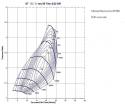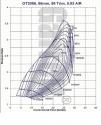Цитата(RXO @ 24.8.2008, 17:16)

В общем непонятки. Судя по давлению в рампе, буст получился 0,4. По давлению в задроселе он =0,1 Где то туфта...
Мерил расход масла через улитку, результат отвратительный( Было 250мл в мин - ни в какие ворота, а я блин так уже ого сколько наездил. Страл растачивать рестриктор. Расточил в 2-2,5раза, но расход масла увеличился не значительно 350мл( Если держать 2000об, то расход получается ровно 0,5л, что опять же мало(
Теперь первым делом надо срочно налить жидкое масло
из гаретовского фака:
Does my turbo require an oil restrictor?
Oil requirements depend on the turbo's bearing system type. Garrett has two types of bearing systems; traditional journal bearing; and ball bearing.
The journal bearing system in a turbo functions very similarly to the rod or crank bearings in an engine. These bearings require enough oil pressure to keep the components separated by a hydrodynamic film. If the oil pressure is too low, the metal components will come in contact causing premature wear and ultimately failure. If the oil pressure is too high, leakage may occur from the turbocharger seals. With that as background, an oil restrictor is generally not needed for a journal-bearing turbocharger except for those applications with oil-pressure-induced seal leakage. Remember to address all other potential causes of leakage first (e.g., inadequate/improper oil drain out of the turbocharger, excessive crankcase pressure, turbocharger past its useful service life, etc.) and use a restrictor as a last resort. Garrett distributors can tell you the recommended range of acceptable oil pressures for your particular turbo. Restrictor size will always depend on how much oil pressure your engine is generating-there is no single restrictor size suited for all engines.
Ball-bearing turbochargers can benefit from the addition of an oil restrictor, as most engines deliver more pressure than a ball bearing turbo requires. The benefit is seen in improved boost response due to less windage of oil in the bearing. In addition, lower oil flow further reduces the risk of oil leakage compared to journal-bearing turbochargers. Oil pressure entering a ball-bearing turbocharger needs to be between 40 psi and 45 psi at the maximum engine operating speed. For many common passenger vehicle engines, this generally translates into a restrictor with a minimum of 0.040" diameter orifice upstream of the oil inlet on the turbocharger center section. Again, it is imperative that the restrictor be sized according to the oil pressure characteristics of the engine to which the turbo is attached. Always verify that the appropriate oil pressure is reaching the turbo.
The use of an oil restrictor can (but not always) help ensure that you have the proper oil flow/pressure entering the turbocharger, as well as extract the maximum performance.
порусски вкратце, улиткам на подшипниках надо меньше смазки. для втульчатых пишут что рестриктор может быть не обязательным ваще, типа спрашивайте у дилеров по рекомендуемым давлениям
для шариковых еще написано типичный рестриктор 1мм, давляк должен быть 40-45 psi(3 бар?) на макс оборотах
так что может для 1752 на холостых достаточно того что есть сейчас?













